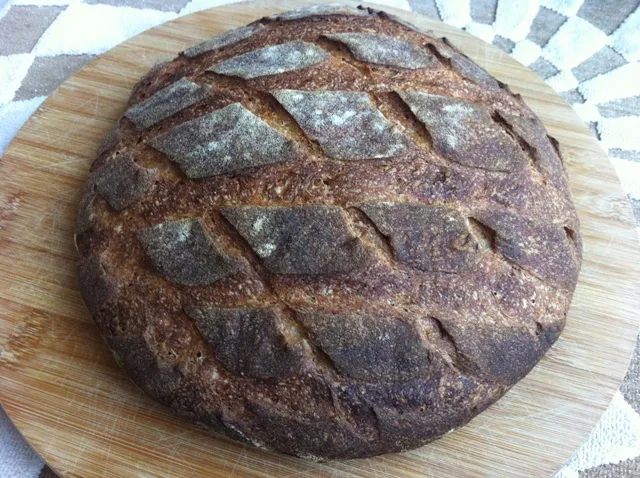Blog posts
Pointe-à-Callière Miche using Atta flour

I’ve been skeptical about the performance of Atta flour in hearth breads. Atta flour is a high extraction Indian stone ground flour used for chapati flat breads. Last week, I picked up a 2 kg bag of the flour from a store, and decided to give it a try in a Miche. I’ve baked the recipe Pointe-à-Callière from Hamleman’s book numerous times before using my home made high extraction flour, so I thought it would be fitting to try Atta flour in Hamelman’s Miche and compare the results.
- Log in or register to post comments
- 23 comments
- View post
- Mebake's Blog
Happy Rosh Hashanah – A Holiday Challah

We were going to make a multi-grain challah but, at the last minute, decided to do a more typical one. It is white bread with saffron, honey, sugar, egg and oil. Pretty standard except the honey sugar egg and oil are a little less than the standard traditional challah - if there is such a thing.
- Log in or register to post comments
- 23 comments
- View post
- dabrownman's Blog
ITJB Honey Whole Wheat Challah
To celebrate the Jewish New Year, 5774, I baked ITJB's Honey Whole Wheat Challah in a round braid, as is traditional for Rosh Hashana. Wishing everyone a very happy, healthy, sweet, peaceful, and prosperous New Year!
In the first photo you can see the indentations from my "poke" test to be sure it was ready for the oven. I didn't use any seeds because my kids prefer their Challah plain.
Sjadad
- Log in or register to post comments
- 13 comments
- View post
- Sjadad's Blog
Two more breads from "Flour Water Salt Yeast"

Ken Forkish's “Pain au Levain” and “Overnight Country Brown”
September 2, 2013
I continued my test baking of the formulas in Ken Forkish's Flour Water Salt Yeast last weekend. I baked two new (to me) formulas. One calls for an overnight bulk fermentation and the other for overnight cold retardation of the shaped loaves.
- Log in or register to post comments
- 29 comments
- View post
- dmsnyder's Blog
Pane Olivia
This is my wife favorite recipe and pretty simple. The recipe is from german baking supply company Bäko Gruppe Nord.
Pane Olivia:
Bread flour ---------------------------------1000g
Water --------------------------------------- 720g
Fresh yeast/ instant yeast -------------- 15g / 6g instant yeast
Salt ----------------------------------------- 22g
Sliced olives ------------------------------ 100g
Sun-dried tomatos ---------------------- 150g
Knead all ingredients except Salt,Olives and Sun-dried tomatos on first/low speed for 4-5 min.
- Log in or register to post comments
- 2 comments
- View post
- Mirko's Blog
Sauerland Black Bread from Gerhard Kellner

My first attempt at making black bread. I used the recipe from Gerhard Kellner's website ketex.de. Google translate worked great at making it a useful recipe. The rest I used Hanseata's guide to German flour and US equivalents.
Having gone through this recipe now I would suggest the following -
1. Soak the old crumbs first and smash them throughly - I found the pieces absorbed too much water and let some out after smash.
2. Soak nuts in a shallower bowl - the nuts at the top of a higher bowl didn't absorb as much water.
- Log in or register to post comments
- 3 comments
- View post
- CrustandCrumb's Blog
SJSD...shape/retard/bake...works like a charm !

David said he had not tried this so I decided to give it a shot. I do it with every SD I bake. I remove from baskets and bake right from refrigerator. It worked fantastically well ! I did 4 loaves as a test one day and then the other 12 the next. I mixed the formula in batches of 4 loaves in my KA for one minute to moisten the flour and transferred them one batch on top of the other to my 13 qt bowl to autolyse. I then did "in the bowl" s and f for 3 turns...this is 6 kilo of dough ! ( I am 5'2" and 115 # :) ) Did 2 s and f on the board.
- Log in or register to post comments
- 21 comments
- View post
- trailrunner's Blog
Sourdough pizza

This sourdough pizza is topped with tomato sauce, caramelized red onions, sauteed chicken thighs in cubes, goat's cheese and arugula.
280 grams of farina di grano tenero 'tipo 00'
165 grams of water
7 grams of salt
100 grams of 100% hydration sourdough (fed with high gluten bread flour).
This gives a total hydration of 65%.
Mixed all ingredients, allowed half an hour of autolyse. The sourdough was fed two days before and kept in fridge after reaching peak activity.
- Log in or register to post comments
- 5 comments
- View post
- MaximusTG's Blog






